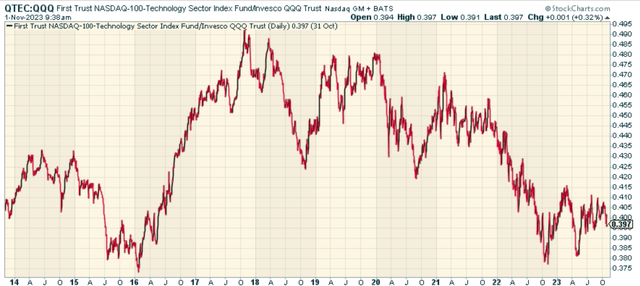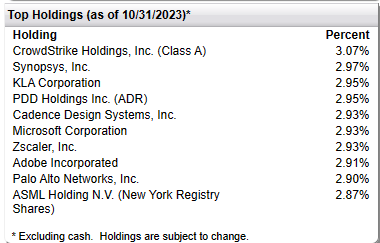Given the risk of the Magnificent 7 breaking given just how well they’ve done this year, it’s worth considering moving away from market-cap weighted averages to more equal weight ones. So let’s say you’re bullish on Technology and the NASDAQ 100, but don’t want to take on the company specific risk that’s in QQQ. What do you do? There’s an ETF for everything, and that’s where the First Trust NASDAQ-100-Technology Sector Index Fund (NASDAQ:QTEC) comes into play.
Overview of QTEC
Launched in April 2006, QTEC is an exchange-traded fund that passively manages assets worth over $2.7 billion. It aims to track the performance of the NASDAQ-100 Technology Sector Index, which comprises companies in the NASDAQ-100 index classified as ‘Technology’ under the Industry Classification Benchmark system. The fund is well-known for its equal-weighting methodology, which ensures a truly diversified portfolio across all size segments in the technology sector.
This equal weighting methodology has NOT helped the fund clearly since 2017. When we compare QTEC to the market-cap weighted QQQ, we can see the ratio topped in 2017 and has badly underperformed. Part of this is the incredibly concentrated momentum in the Magnificent 7 stocks, but also the fact that in general, more mid-to-small-cap companies have had no real momentum for some time now.
stockcharts.com
The fund’s top ten holdings account for approximately 30% of the total assets under management. These include well-known names such as CrowdStrike, Synopsis, KLA Corporation, and others. Despite being equally weighted, the fund’s top holdings change based on performance and can differ greatly from those of other market-cap-weighted funds.
ftportfolios.com
Peer Comparison
When compared with similar ETFs, QTEC stands out for its equal-weighted focus on technology companies. For instance, the iShares U.S. Technology ETF (IYW) is a market-cap-weighted alternative. QTEC’s lower exposure to mega-cap stocks and focus on smaller-capitalized companies makes it a compelling choice for investors seeking diversified tech exposure if you’re worried about the large-cap generals falling.
Potential investors should be aware of the fund’s relatively higher expense ratio of 0.57%. While this is common among many First Trust ETFs, it is something to consider when comparing QTEC to other ETFs in the technology sector.
Risks and Considerations
Investing in QTEC, like any investment, comes with its share of risks. The rich valuation of the tech sector and the fund’s high exposure to this sector could pose potential downside risks in the event of a market downturn independent of the weightings within the fund. The Price/Earnings ratio stands at 28.12 – not exactly cheap, with Price/Sales at 6.36. So while it’s better in my view than QQQ here, it’s certainly not a value play.
Conclusion
QTEC presents a unique investment opportunity for those seeking diversified exposure to the technology sector. Its equal-weighting methodology and focus on smaller-capitalized tech companies set it apart from other funds in the space. However, potential investors should weigh the fund’s high expense ratio and market risks against its benefits before making an investment decision. From an equal weight fund perspective, there’s no question that QTEC appears to have rolled over and is now entering a downtrend. If I had to choose between QQQ and QTEC longer-term, I’d go with QTEC here, but would rather wait for the macro backdrop to get better.
Markets aren’t as efficient as conventional wisdom would have you believe. Gaps often appear between market signals and investor reactions that help give an indication of whether we are in a “risk-on” or “risk-off” environment.
The Lead-Lag Report can give you an edge in reading the market so you can make asset allocation decisions based on award winning research. I’ll give you the signals–it’s up to you to decide whether to go on offense (i.e., add exposure to risky assets such as stocks when risk is “on”) or play defense (i.e., lean toward more conservative assets such as bonds/cash when risk is “off”).
Read the full article here



